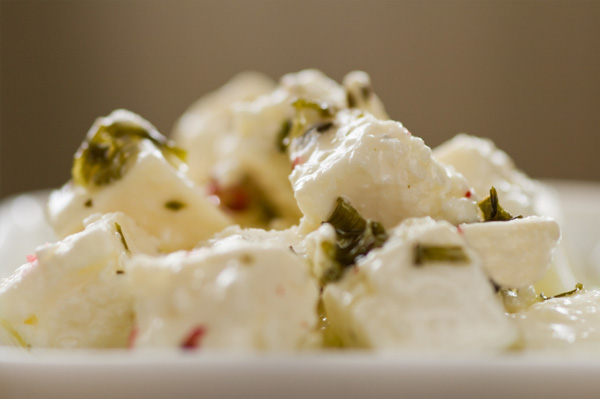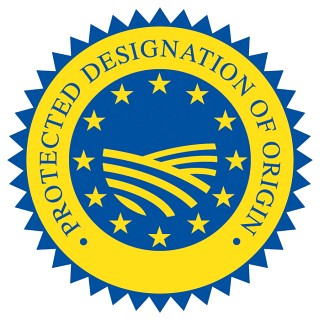
- Feta can be made from sheep's milk or a blend of 70% sheep's and 30% goat's milk. Thus, even though goat's milk is involved, the sheep win over the goats.
- Non-Greek or large producers may make feta from cow's milk. The problem with this is that cow's milk has proteins of enormous size that are responsible for giving a lot of people problems digesting the lactose. Goat's milk and sheep's milk both have lactose in them, but the proteins are shaped differently, so people have less trouble digesting them.
- Another problem with using cow's milk is that it makes the cheese turn a yellowish color, so the producers then dye the cheese to make it white like the traditional feta.
- Feta is made by curdling it first with rennet (rennet-free varieties are available in some areas). It is then separated and drained in a bag or special mold. Then it's cut into large slices -- and here's where the word feta comes from, for it means "slice." The slices are salted and then packed into brine-filled barrels. It soaks in this salty brine for two months.
- If the cheese you've gotten has aged for less than two months, it's not considered to be fully matured, and it may not taste as excellent as it could.
- After you've bought a package of feta and brought it home and opened it and eaten some but not all of it, you'll want to keep the remaining feta in the brine; otherwise, it'll dry out.
- If you want to make your own feta (and I've considered doing this many times), here's a recipe.

Feta, the star.
(Photo from SheKnows)
(Photo from SheKnows)
- The Greeks love their feta, too, obviously. One of my sources notes that people in other European countries restrict their cheese-eating to particular meals of the day, or specific parts of a meal, such as appetizers only or evening desserts only. The Greeks, however, "consume cheese at all times." They even have a cheese pie, tyropita, that can be eaten any time of day. So it is safe to say, "For the Greeks, cheese is not a food supplement, it is food."
- In the Odyssey, the cyclops is making a cheese in his cave out of sheep's milk. It's thought that this is one of the earliest forms of feta. The story of how he made his cheese (or discovered that his milk had become cheese) sounds an awful lot like the story people tell about the origin of all cheese in general.
- The Greeks' strong attachment to their cheese and their pride in the history of their cheese may account for the politicization of feta.
- With the formation of the EU, many European countries started making products that were traditionally available from just one European country. For example, for years and years you could only get feta from Greece, but then everybody started making feta and saying it was as good as feta from Greece, even though it might be made differently.
- So then the "home" countries got protective of their original products. And now, the only feta that can be labeled feta is that which was made in Greece. Feta that comes from Bulgaria, for example, should be called "Bulgarian sheep's milk cheese."
- The Greek restaurant here in town, where I got the Greek salad, has a display case with several cheeses in it. Only one cheese is labeled "Feta." The rest are labeled various forms of "sheep's milk cheese."
- If you buy a hunk of feta and the packaging calls it feta but doesn't include the acronym PDO (for protected designation of origin), you've bought non-Greek, imposter feta. It could also mean that the cheese you've bought may contain extra chemical substances for maturing or coloring, or the milk may contain antibiotics.
Sources
Food Reference, Feta Cheese
Wikipedia, Feta (cheese)
Greek Products.com, About Feta Cheese and Feta Cheese - a protected product of Name of Origin
American University, The Mandala Projects, Trade & Environment Database Case Studies, Feta Cheese
American University, The Mandala Projects, Trade & Environment Database Case Studies, Feta 2: The Feta Cheese Wars, by Georgia Economou
European Commission, Agriculture division, Protected Designation of Origin

No comments:
Post a Comment
If you're a spammer, there's no point posting a comment. It will automatically get filtered out or deleted. Comments from real people, however, are always very welcome!